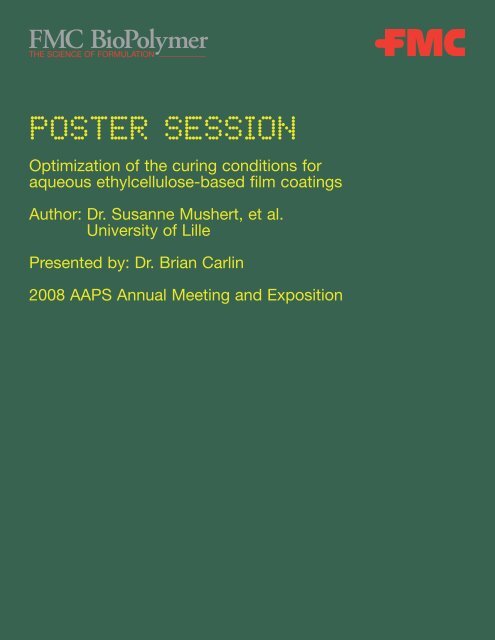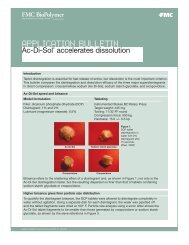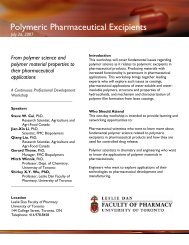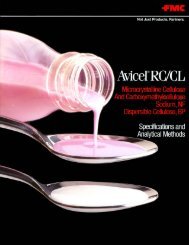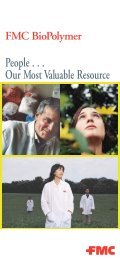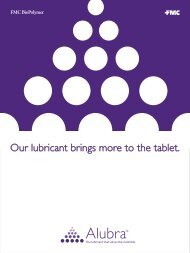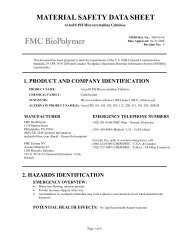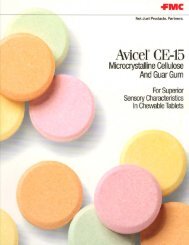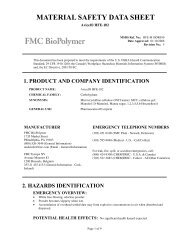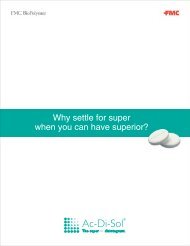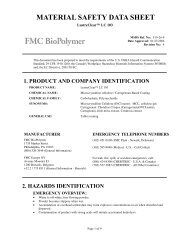POSTER SESSION - FMC BioPolymer
POSTER SESSION - FMC BioPolymer
POSTER SESSION - FMC BioPolymer
- No tags were found...
You also want an ePaper? Increase the reach of your titles
YUMPU automatically turns print PDFs into web optimized ePapers that Google loves.
<strong>FMC</strong> <strong>BioPolymer</strong>THE SCIENCE OF FORMULATION<strong>POSTER</strong> <strong>SESSION</strong>Optimization of the curing conditions foraqueous ethylcellulose-based film coatingsAuthor: Dr. Susanne Mushert, et al.University of LillePresented by: Dr. Brian Carlin2008 AAPS Annual Meeting and Exposition
OPTIMIZATION OF THE CURING CONDITIONS FORAQUEOUS ETHYLCELLULOSE-BASED FILM COATINGSSusanne Muschert, 1 Florence Siepmann, 1 Bruno Leclercq, 2 Brian Carlin, 3 Juergen Siepmann 11College of Pharmacy, JE 2491, University of Lille, 3, Rue du Prof. Laguesse, 59006 Lille, France2<strong>FMC</strong> <strong>BioPolymer</strong>, Avenue Mounier 83, 1200 Brussels, Belgium3<strong>FMC</strong> <strong>BioPolymer</strong>, US Route 1 & Plainsboro Road, Princeton, NJ 08543, USAIntroductionAqueous ethylcellulose coatings are highly suitable tocontrol drug release from single and multiple unitdosage forms. However, the resulting drug releaserate might be low. To overcome this restriction smallamounts of poly(vinyl alcohol)-poly (ethylene glycol)graft copolymer (PVA-PEG-graft-copolymer) can beadded 1 . Furthermore, it could be shown that longterm stable drug release patterns can be achievedeven upon open storage under stress conditionswhen the systems are cured for 2 d at 60°C and 75%RH 2 . However, yet the required minimal curingconditions for this type of polymeric coating areunknown.ObjectiveTo identify the minimal curing time and temperaturerequired to obtain long term stable film coatingsprepared from aqueous ethylcellulose dispersioncontaining small amounts of the release rate modifierand stabilizer PVA-PEG-graft-copolymer.ExperimentalTheophylline matrix cores were coated with aqueousethylcellulose dispersion (Aquacoat ® ECD, plasticizedwith 25% triethyl citrate), containing 15% PVA-PEGgraft-copolymerin a fluidized bed coater (coatinglevel = 15%). The pellets were oven cured at differenttemperatures (ranging from 40 to 60°C) duringvarious time periods (ranging from 2 to 24 h). Drugrelease was measured in phosphate buffer pH 7.4(USP paddle apparatus, 37°C, UV drug detection)before and after 6 and 12 months open storage.Results and DiscussionFigure 1: Influenceof the curing time(indicated in the figure)on theophyllinerelease from ethylcellulose:PVA-PEGgraft-co-polymer85:15 coated drugmatrix cores in 0.1 MHCl for 2 h,followed by phosphatebuffer pH 7.4(curing temperature:60°C).Figure 2: Influenceof the curing temperature(indicated inthe figure) ontheophylline releasefrom ethylcellulose:PVA-PEG- graftcopolymer85:15coated drug matrixcores in phosphatebuffer pH 7.4 (curingtime:24 h).
(3a)(3b)Figure 3: Storagestability of ethylcellulose:PVA-PEG-graftcopolymer85:15coated theophyllinematrix cores curedunder the followingconditions: (3a) 2 hat 60°C, (3b) 8 h50°C and (3c) 24 h60°C. Drug releasebefore and after 6and 12 months openstorage underambient conditionsin 0.1 M HCl for 2 h,followed by phosphatebuffer pH 7.4.ConclusionsCuring for 2 h at 60°C or for 8h at 50°C is sufficientto allow for the formation of long term stable filmcoatings from aqueous ethylcellulose dispersion inthe presence of small amounts of water trappingPVA-PEG-graft-copolymer amounts water PVA-PEGgraft-copolymer.References1. S. Muschert et al., 35th International Symposium onControlled Release of Bioactive Materials, Controlled ReleaseSociety, New York, USA, #519, 2008.2. F. Siepmann et al., J. Control. Release 126, 26-33, 2008.www.fmcbiopolymer.comwww.univ-lille2.fr.(3c)
The following are trademarks or service marks of<strong>FMC</strong> Corporation or its subsidiaries, which maybe Registered U.S. Patent & Trademark Office andin other countries: <strong>FMC</strong> logo, Aquacoat, The Scienceof Formulation, and The Science of Formulation Mark.© <strong>FMC</strong> Corporation. All rights reserved.www.fmcbiopolymer.compharm_info@fmc.comA/P-155 (AAPS Nov., 2008).RS


